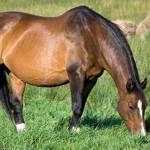Eastern Tent Caterpillars Threaten Broodmares in Kentucky

Eastern tent caterpillars are dispersing from wild cherry trees and may be found on fences, barn surfaces, and grass blades in central Kentucky.
Though horses don’t seek them out as they graze, the caterpillars may accidentally be ingested by pastured broodmares. Stiff hair-like projections on a caterpillar’s skin can irritate or puncture the mare’s digestive tract, allowing bacteria to escape from the gut and settle in placental and fetal tissues. This phenomenon was responsible for outbreaks of mare reproductive loss syndrome (MRLS) that decimated foal populations a decade ago in central Kentucky and some other locations.
Control of the caterpillars with sprayed insecticides is usually ineffective, and manual removal from premises is impractical in years when climatic conditions favor a large population. To avoid fetal loss, owners are advised to move pregnant mares to pastures that are at least several hundred feet from wild cherry trees.








